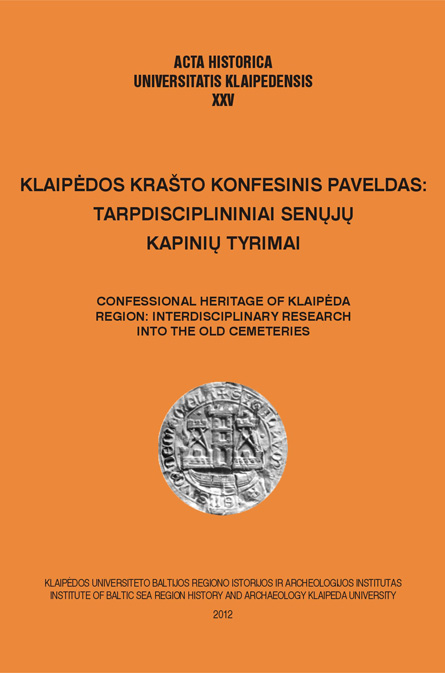Volume 25 (2012): Klaipėdos krašto konfesinis paveldas: tarpdisciplininiai senųjų kapinių tyrimai = Confessional Heritage of Klaipėda Region: Interdisciplinary Research into the Old Cemeteries, December 2012

Order by:
Pub. online: 3 Dec 2012
Type: Introduction
 Open Access
Open Access
Journal:
Acta Historica Universitatis Klaipedensis
Volume 25 (2012): Klaipėdos krašto konfesinis paveldas: tarpdisciplininiai senųjų kapinių tyrimai = Confessional Heritage of Klaipėda Region: Interdisciplinary Research into the Old Cemeteries, pp. 5–12
Pub. online: 3 Dec 2012
Type: Article
 Open Access
Open Access
Journal:
Acta Historica Universitatis Klaipedensis
Volume 25 (2012): Klaipėdos krašto konfesinis paveldas: tarpdisciplininiai senųjų kapinių tyrimai = Confessional Heritage of Klaipėda Region: Interdisciplinary Research into the Old Cemeteries, pp. 13–33
Abstract
Pub. online: 3 Dec 2012
Type: Article
 Open Access
Open Access
Journal:
Acta Historica Universitatis Klaipedensis
Volume 25 (2012): Klaipėdos krašto konfesinis paveldas: tarpdisciplininiai senųjų kapinių tyrimai = Confessional Heritage of Klaipėda Region: Interdisciplinary Research into the Old Cemeteries, pp. 34–61
Abstract
Pub. online: 3 Dec 2012
Type: Article
 Open Access
Open Access
Journal:
Acta Historica Universitatis Klaipedensis
Volume 25 (2012): Klaipėdos krašto konfesinis paveldas: tarpdisciplininiai senųjų kapinių tyrimai = Confessional Heritage of Klaipėda Region: Interdisciplinary Research into the Old Cemeteries, pp. 62–76
Abstract
Pub. online: 3 Dec 2012
Type: Article
 Open Access
Open Access
Journal:
Acta Historica Universitatis Klaipedensis
Volume 25 (2012): Klaipėdos krašto konfesinis paveldas: tarpdisciplininiai senųjų kapinių tyrimai = Confessional Heritage of Klaipėda Region: Interdisciplinary Research into the Old Cemeteries, pp. 77–88
Abstract
Pub. online: 3 Dec 2012
Type: Article
 Open Access
Open Access
Journal:
Acta Historica Universitatis Klaipedensis
Volume 25 (2012): Klaipėdos krašto konfesinis paveldas: tarpdisciplininiai senųjų kapinių tyrimai = Confessional Heritage of Klaipėda Region: Interdisciplinary Research into the Old Cemeteries, pp. 89–122
Abstract
Pub. online: 3 Dec 2012
Type: Article
 Open Access
Open Access
Journal:
Acta Historica Universitatis Klaipedensis
Volume 25 (2012): Klaipėdos krašto konfesinis paveldas: tarpdisciplininiai senųjų kapinių tyrimai = Confessional Heritage of Klaipėda Region: Interdisciplinary Research into the Old Cemeteries, pp. 123–136
Abstract
Pub. online: 3 Dec 2012
Type: Article
 Open Access
Open Access
Journal:
Acta Historica Universitatis Klaipedensis
Volume 25 (2012): Klaipėdos krašto konfesinis paveldas: tarpdisciplininiai senųjų kapinių tyrimai = Confessional Heritage of Klaipėda Region: Interdisciplinary Research into the Old Cemeteries, pp. 137–161
Abstract
Pub. online: 3 Dec 2012
Type: Article
 Open Access
Open Access
Journal:
Acta Historica Universitatis Klaipedensis
Volume 25 (2012): Klaipėdos krašto konfesinis paveldas: tarpdisciplininiai senųjų kapinių tyrimai = Confessional Heritage of Klaipėda Region: Interdisciplinary Research into the Old Cemeteries, pp. 162–177
Abstract
Pub. online: 3 Dec 2012
Type: Article
 Open Access
Open Access
Journal:
Acta Historica Universitatis Klaipedensis
Volume 25 (2012): Klaipėdos krašto konfesinis paveldas: tarpdisciplininiai senųjų kapinių tyrimai = Confessional Heritage of Klaipėda Region: Interdisciplinary Research into the Old Cemeteries, pp. 178–195
Abstract